Difference between revisions of "Dissociative"
Mindlusion (Talk | contribs) |
Mindlusion (Talk | contribs) |
||
| Line 5: | Line 5: | ||
NONcompetitive antagonists result in the same affect on the receptor, but achieve it in a slightly different way. | NONcompetitive antagonists result in the same affect on the receptor, but achieve it in a slightly different way. | ||
| − | See images D & E [[File: | + | See images D & E [[File:NewNMDA.PNG]] |
Revision as of 22:30, 9 December 2012
Dissociatives are a class of hallucinogen, which distort perceptions of sight and sound and produce feelings of detachment - dissociation - from the environment and self. This is done through reducing or blocking signals to the conscious mind from other parts of the brain. Although many kinds of drugs are capable of such action, dissociatives are unique in that they do so in such a way that they produce hallucinogenic effects, which may include sensory deprivation, dissociation, hallucinations, and dream-like states or trances. Some, which are nonselective in action and affect the dopamine and/or opioid systems, may be capable of inducing euphoria. Many dissociatives have general depressant effects and can produce sedation, respiratory depression[citation needed], analgesia, anesthesia, and ataxia, as well as cognitive and memory impairment and amnesia.
The primary area of activation for dissociatives is blockade of the Ca++ ion in the NDMA receptor. Also known as uncompetitive NMDA receptor antagonists.
NONcompetitive antagonists result in the same affect on the receptor, but achieve it in a slightly different way.
Dissociatives can also be classified by molecular structure. The most well known dissociatives used recreationally and in medicine are known as arylcyclohexylamines 
Another well known dissociative Dextromethorphan (DXM) has a very opioid like structure. It is classified as a morphinan
---NMDA receptor antagonists---
Adamantanes
Amantadine
Memantine
Rimantadine
Arylcyclohexylamines
Dieticyclidine
Esketamine
Eticyclidine
Gacyclidine
Ketamine
Metaphit
Methoxetamine
Neramexane
Phencyclidine (PCP)
Phenylhexylcyclopyrrolidine
Rolicyclidine
Tenocyclidine
Tiletamine
Methoxydine (4-MeO-PCP)
Morphinans----
Dextromethorphan Dextrorphan Methorphan Morphanol Others 2-MDP 8A-PDHQ Aptiganel Dexoxadrol Diethyl ether Dizocilpine Etoxadrol Ibogaine (found in Tabernanthe iboga) Midafotel NEFA Nitrous oxide Noribogaine Perzinfotel Remacemide Selfotel Xenon
---kappa-opioid agonists---
salvinorin
